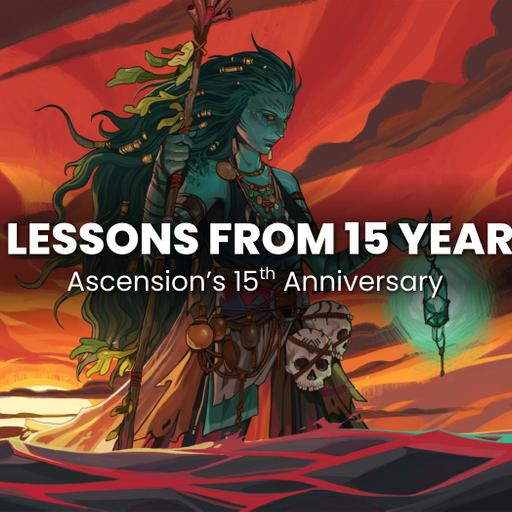
21 Aug 2025 03:02
Justin Gary — 5 Lessons From 15 Years (#90)
At Gen Con this year, we kicked off Ascension’s 15-year anniversary celebration. I had the chance to meet so many fans who have been part of this community for over a decade; the experience was both humbling and rewarding.
We just launched the Gamefound Campaign for the Ascension 15th Anniversary Collector’s Edition and I’ve been reflecting on the incredible journey that brought us here. What began as a casual prototype I created to play with friends between rounds of Magic tournaments has grown into a game that connects millions of players around the world.
Here are the five most important lessons I've learned, each has transformed Ascension from a prototype to a global phenomenon.
Lesson 1: Prototype and Iterate Fast
When I first started working on Ascension, I never expected it to become the success it is today. It was 2009, and I had just quit my job to start my own game company. The funny thing about starting a company is that until you’re making money and collaborating with others, the difference between “CEO/Game Designer” and “guy sitting on his couch” is mostly a matter of attitude.
At the time, I had spent over a hundred hours playing the deckbuilding game Dominion. This game pioneered the genre, offering the fun of deckbuilding without the hassle of collecting cards. As a Magic: The Gathering Pro, I loved that it delivered the joy of constructing a deck without buying packs or managing a collection. Eventually, however, the game became predictable. Because each setup of available cards was fixed from the start, I rarely needed to change my strategy. I also found that the game took too long to set up, impacting the ratio of fun to busy work in a way I thought could be improved.
The secret to creating Ascension was simple: remove the things from Dominion that get in the way of fun.
My first prototype was literally just a shuffled pile of Dominion cards, which instantly cut 20 minutes off setup time. Mind you, this prototype wasn’t good, but it gave me a quick sense of how the gameplay might feel, and I could see a spark of something great there. My next prototype was nothing more than sharpie scribbles on blank cards. Since my prototypes were quick and ugly, I had no problem throwing them out and making rapid changes. That freedom allowed Ascension to go from idea to store shelves in under 18 months.
The lesson: Your first prototype should be so ugly you're embarrassed to show it to anyone. That embarrassment is freedom—freedom to fail fast, change everything, and find the fun without falling in love with your first ideas.
Lesson 2: When in Doubt, Cut it out
Most new designers try to solve problems by adding things to their games. The correct answer is almost always to cut instead.
Ascension started by cutting Dominion’s purchase and play restrictions. This streamlined the game and gave players more choices each turn, but also required me to add a second resource [power] to keep tension high. This change was just the start, the biggest cut came much later in development.
Ascension’s signature innovation was the ever changing center row, which dramatically increased the variety in each game. At the same time, this mechanic also created the risk of a stalled board state, meaning that if players weren’t able to buy anything from the center, nothing would change and the game would drag on. My original solution was a “conveyor belt” mechanic, where, at the end of each turn, the rightmost card was banished and everything slid down. This guaranteed movement and created tension as cards neared the edge.
The problem was that players kept forgetting to slide the cards down. Every. Single. Game.
I tried everything: special cards tha
